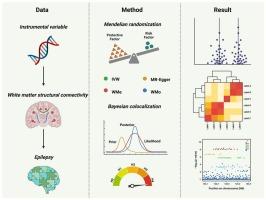白质结构连通性与癫痫的因果关系
IF 2.3
3区 医学
Q2 BEHAVIORAL SCIENCES
引用次数: 0
摘要
最近,白质结构连通性与癫痫发病机制有关,但其因果作用尚不清楚。本研究采用孟德尔随机化(MR)研究白质结构连通性与癫痫的因果关系。GWAS白质结构连通性的汇总统计数据来自UK Biobank,而癫痫数据来自FinnGen R10和国际抗癫痫联盟(ILAE)。我们的MR分析揭示了白质结构连通性与癫痫风险之间的重要因果关系。在FinnGen_R10_FE_STRICT中,右半脑视觉和突出/腹侧注意网络(RH Vis到RH Sal/VentAttn WMSC)之间的连接性增加与较高的癫痫风险相关(OR = 2.25, 95% CI = 1.43-3.56, p <;0.01, FDR p = 0.019)。相反,在FinnGen_R10_GE_STRICT中,左右半球显著性/腹侧注意网络(LH Sal/VentAttn至RH Sal/VentAttn WMSC)之间的连接性增加与癫痫风险降低有关(OR = 0.17, 95% CI = 0.07-0.46, p <;FDR p = 0.033)。跨数据集共确定了15个名义上显著的关联。这些发现表明白质结构连接与癫痫之间存在因果关系,为疾病机制和潜在治疗靶点提供了见解。本文章由计算机程序翻译,如有差异,请以英文原文为准。

Causal relationship between white matter structural connectivity and epilepsy
White matter structural connectivity has recently been linked to epilepsy pathogenesis, yet its causal role remains unclear. This study used Mendelian randomization (MR) to investigate the causal relationship between white matter structural connectivity and epilepsy. GWAS summary statistics for white matter structural connectivity were sourced from the UK Biobank, while epilepsy data were obtained from FinnGen R10 and the International League Against Epilepsy (ILAE). Our MR analysis revealed significant causal links between white matter structural connectivity and epilepsy risk. Increased connectivity between the right hemisphere visual and salience/ventral attention networks (RH Vis to RH Sal/VentAttn WMSC) was associated with higher epilepsy risk in FinnGen_R10_FE_STRICT (OR = 2.25, 95 % CI = 1.43–3.56, p < 0.01, FDR P = 0.019). Conversely, increased connectivity between left and right hemisphere salience/ventral attention networks (LH Sal/VentAttn to RH Sal/VentAttn WMSC) was linked to reduced epilepsy risk in FinnGen_R10_GE_STRICT (OR = 0.17, 95 % CI = 0.07–0.46, p < 0.01, FDR P = 0.033). A total of 15 nominally significant associations were identified across datasets. These findings suggest a causal relationship between white matter structural connectivity and epilepsy, offering insights into disease mechanisms and potential therapeutic targets.
求助全文
通过发布文献求助,成功后即可免费获取论文全文。
去求助
来源期刊

Epilepsy & Behavior
医学-行为科学
CiteScore
5.40
自引率
15.40%
发文量
385
审稿时长
43 days
期刊介绍:
Epilepsy & Behavior is the fastest-growing international journal uniquely devoted to the rapid dissemination of the most current information available on the behavioral aspects of seizures and epilepsy.
Epilepsy & Behavior presents original peer-reviewed articles based on laboratory and clinical research. Topics are drawn from a variety of fields, including clinical neurology, neurosurgery, neuropsychiatry, neuropsychology, neurophysiology, neuropharmacology, and neuroimaging.
From September 2012 Epilepsy & Behavior stopped accepting Case Reports for publication in the journal. From this date authors who submit to Epilepsy & Behavior will be offered a transfer or asked to resubmit their Case Reports to its new sister journal, Epilepsy & Behavior Case Reports.
 求助内容:
求助内容: 应助结果提醒方式:
应助结果提醒方式:


